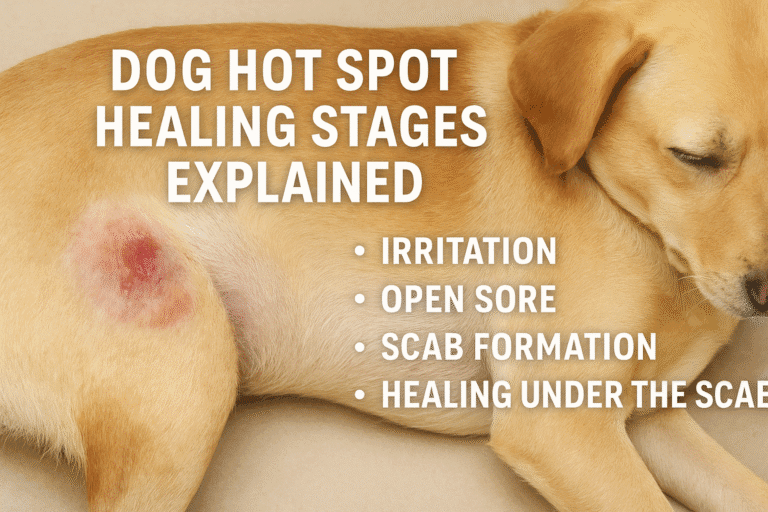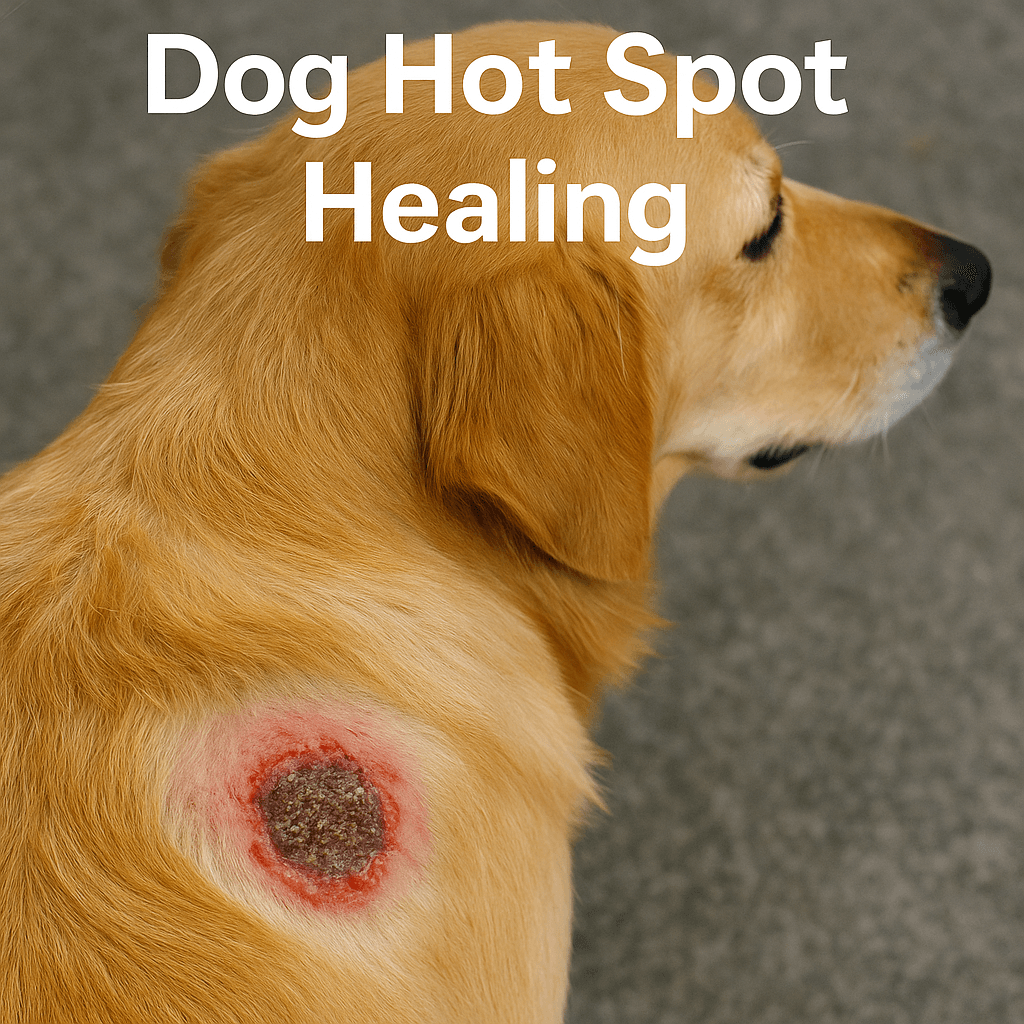Dog Hot Spot Healing Stages Explained

Pet owners often witness sudden changes that feel confusing and stressful. One minute, a furry companion seems perfectly content, and soon after, they’re fixated on licking and chewing one spot nonstop. That red, inflamed patch—called acute moist dermatitis—can appear without warning, expand rapidly, and turn quite severe if not addressed with proper care and attention.
Good news—those irritated patches can fade completely with careful attention. This detailed outline walks through every stage of recovery, pointing out what signs may appear, how long improvement might take, and practical ways to bring comfort to your furry companion throughout the process.
What Is a Dog Hot Spot?
An irritated, infected patch on their skin can show up out of nowhere and get worse fast. It often starts because they’ve been licking, chewing, or scratching one area too much. That constant attention usually comes from something deeper bothering them underneath, like:
Flea bites or insect stings
-
Allergies (food, seasonal, environmental)
Moisture caught beneath fur (for example, after swimming)
Ear infections
Dirty or matted coats
Cuts, scrapes, or irritations that get licked
Once they start obsessing over an itch or irritation, it quickly snowballs into an open sore—and just like that, it turns into a red, oozing mess that seems to get worse every time you look.
How to Recognize a Hot Spot
Spotting it early makes a huge difference. Watch for these warning signs:
Red, inflamed skin
Wet or oozing wound
Fur thinning or loss around affected area
Intense licking, biting, or scratching
Bad odor from the infected spot
Scab formation in later stages
Pain when touched
Itchy flare-ups usually appear around areas such as head, neck, hips, or legs. Breeds with thick or lengthy coats—such as Golden Retrievers, Labradors, and German Shepherds—experience this condition more often due to trapped moisture and limited airflow beneath dense fur.
6 Stages of Dog Hot Spot Recovery
Now, let’s move carefully through every stage they experience—from that first instant when a small irritated patch shows up, right up to when fresh fur starts growing back and soothing comfort finally returns across their skin.
Stage 1: Irritation and Overgrooming (Days 1–2)
What’s Happening:
Now, step by step, each phase unfolds—from that very first instant when an itchy patch shows up, continuing through every stage of recovery, until fresh fur starts to grow back and a soothing sense of relief returns to their skin.
Signs You’ll See:
Redness
Hair loss
Moist skin
They just keep scratching and licking that same irritated area—can’t seem to leave it alone.
What You Should Do:
Stop licking right away. Use an e-collar (cone), bandage, or soft inflatable collar to prevent further irritation.
Examine for fleas, wounds, or possible allergies.
Gently cleanse area using chlorhexidine, saline, or an antiseptic wipe designed for pets.
Call your vet if it’s worsening or if you’re unsure. Early treatment stops it from progressing.
Stage 2: Open Sore and Bacterial Infection (Days 2–4)
What’s Happening:
Repeated licking or chewing has caused skin to break, creating an opening for bacteria. Infection has developed, leading to a severe phase of irritation—painful, foul-smelling, and very distressing to observe.
Signs You’ll See:
Weeping wound or pus
Bad smell
Swelling
High sensitivity to touch
Worsening hair loss
What You Should Do:
See your vet. Most need oral antibiotics, topical treatments, or anti-inflammatories at this stage.
A vet might trim fur around that spot to improve air circulation and make treatment more effective.
Clean that area two or three times a day, make sure it stays completely dry, and then apply a veterinary-grade ointment or cream to encourage proper recovery.
Keep that cone or e-collar on to prevent any licking or biting at the affected area. It serves as a barrier, allowing proper recovery without interference. Removing it too soon might cause irritation or reopen healing spots, so make sure it stays on until complete recovery is confirmed.
Important Note: Skip using human ointments such as Neosporin unless a veterinarian specifically approves it. Certain ingredients found in these creams can cause irritation or other harmful reactions for pets.
Stage 3: Scab Formation and Drying Out (Days 5–7)
What’s Happening:
Infection starts easing off, allowing the wound to dry out and form a protective crust or scab. Hair may still appear thin or missing in that area, yet swelling and redness gradually fade away.
Signs You’ll See:
Reduced redness and swelling
Formation of a dry, hardened layer on top of a wound as it begins to close and recover. This protective covering shields underlying tissue from dirt and bacteria while allowing natural repair to progress underneath. Over time, this layer may loosen and detach on its own as fresh skin develops beneath it.
Less oozing
What You Should Do:
Continue gentle cleaning to prevent disturbing or loosening any forming scab.
Maintain medications until finished (don’t stop antibiotics early).
Keep area dry—avoid swimming or bathing pets unless specifically advised.
Continue monitoring for signs of itching or relapse.
Pro Tip: Fresh air makes a big difference. When possible, let them relax in a dry, well-ventilated space inside.
Stage 4: Skin Restoration Under Crust (Days 7–14)
What’s Happening:
Beneath that surface, fresh skin cells start to take shape while internal systems work hard to rebuild deeper layers. Around this stage, restoration begins to speed up and progress becomes more noticeable.
Signs You’ll See:
Smaller scab
No more wetness
Less sensitivity
New skin tissue starting to show
What You Should Do:
Refrain from touching or scraping off that scab. Allow it to come away on its own once healing has progressed fully.
Reapply healing ointments if prescribed.
Allow air to circulate around that spot, yet keep the cone in place whenever licking begins again.
Watch for signs of re-infection (like renewed redness or pus).
Stage 5: Scab Falls Off, Pink Skin Appears (Days 14–21)
What’s Happening:
The scab has done its job and now starts to flake off naturally. Underneath, you’ll see new, pink skin. It might look a little weird or shiny—but that’s a good sign.
Signs You’ll See:
Scab shrinks or flakes away
Pink, delicate new skin underneath
Slight itching (healing itch)
Hair starts to grow back
What You Should Do:
Avoid scratching while scab is falling off—itching might come back briefly.
Certain treatments may now be stopped once approval comes from your vet.
Keep pets well-groomed to prevent mats or irritants from accumulating around affected areas.
Certain animals may notice darker patches or scarring on skin around that spot. Over a period, such marks often fade gradually, returning closer to normal tone.
Stage 6: Full Recovery and Hair Regrowth (3–6 Weeks After Start)
What’s Happening:
Skin grew firm and gained a healthy pink tone, fur started filling out once more, and your furry companion returned to a cheerful, lively state. That sore vanished completely, leaving no mark behind.
Signs You’ll See:
Full closure of wound
Pink skin fading to match normal tone
Fur regrowth
No more itching, licking, or scratching
What You Should Do:
No more treatment needed—just regular grooming and prevention.
Figure out what first caused irritation—maybe an allergy, flea bite, or another source—and take action to keep such flare-ups from returning.
Give yourself some credit for handling this like a caring and dedicated animal guardian!

Timeline Overview: Stages of Skin Lesion Improvement in Canines
| Healing Stage | Days | What’s Happening |
|---|---|---|
| Stage 1: Irritation | 1–2 | Red, moist, itchy area from licking/chewing |
| Stage 2: Infection | 2–4 | Oozing wound, smells bad, inflamed |
| Stage 3: Scab Formation | 5–7 | Starts drying out, crusts form |
| Stage 4: Healing Under Scab | 7–14 | Skin regenerates under scab |
| Stage 5: Scab Falls Off | 14–21 | Pink skin appears, mild itch |
| Stage 6: Full Recovery | 3–6 weeks | Hair regrows, skin returns to normal |
How to Speed Up Your Furry Friend’s Soothing Process
Vet-prescribed treatments are always best
Cone or collar to prevent licking
Clean with pet-safe antiseptic
Dry the area thoroughly
Watch for reinfection signs
Keep your furry friend comfortable, dry, and relaxed.
Frequently Asked Questions from Caring Owners
Is it safe to pop or drain an irritated skin area?
Never attempt to burst or drain a sore on your own. Once skin integrity is compromised, it becomes prone to infection. Trying to open or press on an irritated spot at home can push bacteria further inside or spread it to nearby areas, often worsening pain and swelling. Such actions may turn a minor issue into a serious complication requiring advanced attention. A qualified professional has sterile tools and the right setting to manage wounds safely and effectively when required. Allowing an expert to handle it ensures comfort for your furry companion and reduces chances of the issue getting worse.
Can I use coconut oil or natural remedies?
In certain cases, applying coconut oil can calm and moisturize mildly irritated skin, especially when surfaces remain intact. Natural antibacterial and anti-inflammatory properties provide soothing comfort. Professional guidance is essential if areas appear raw, damaged, or show signs of infection. Applying coconut oil to open wounds without expert advice may trap bacteria or worsen conditions. A trained professional can determine if this natural remedy is safe for an individual animal’s situation.
How can I stop these skin irritations from returning?
Control fleas
Manage allergies
Maintain your furry friend’s coat clean and dry.
Brush out matted fur
Address boredom or anxiety that leads to licking
When to Reach Out to a Vet
Call your vet if:
Hot spot begins to spread or grow worse
There’s blood or pus
Your furry friend is experiencing significant discomfort.
Fever or lethargy develops
It doesn’t improve after 2–3 days of care
Final Thoughts: Patience, Love, and a Little TLC
Seeing your furry friend struggle with a painful skin irritation is tough. They feel uncomfortable, and it’s challenging to keep them from scratching that persistent itch.
With quick action, close observation, and steady patience, most instances fade completely within one to three weeks. Key focus stays on stopping continuous licking or scratching, treating any infection present, and giving skin a fair chance to restore itself naturally.
And hey—those belly rubs, treats, and cozy cuddles during this time? They make everything a lot easier for both of you.
Related posts:
- Cat Insulin Cost: How to Save Money in America and Canada
- A Journey of Love: Choosing Not to Treat Feline Diabetes
- Yo, Check Out How We Treat Copper Storage Disease in Dogs!
- Feline Diabetes Mastery: Expert Guide to Cat Insulin Care
- Decoding Red Eyes in Dogs: Could It Be Cancer?
- Exploring Dr. Marty Dog Food on Amazon
- Pawsitive Health: Your Ultimate Cat Diabetes Test Kit Guide
- Dr. Marty Dog Food: Unveiling Complaints
- Blue Buffalo Puppy Food Reviews: Real Talk from a Dog Parent
- Problems with Orijen Dog Food: What Every Dog Owner Should Know